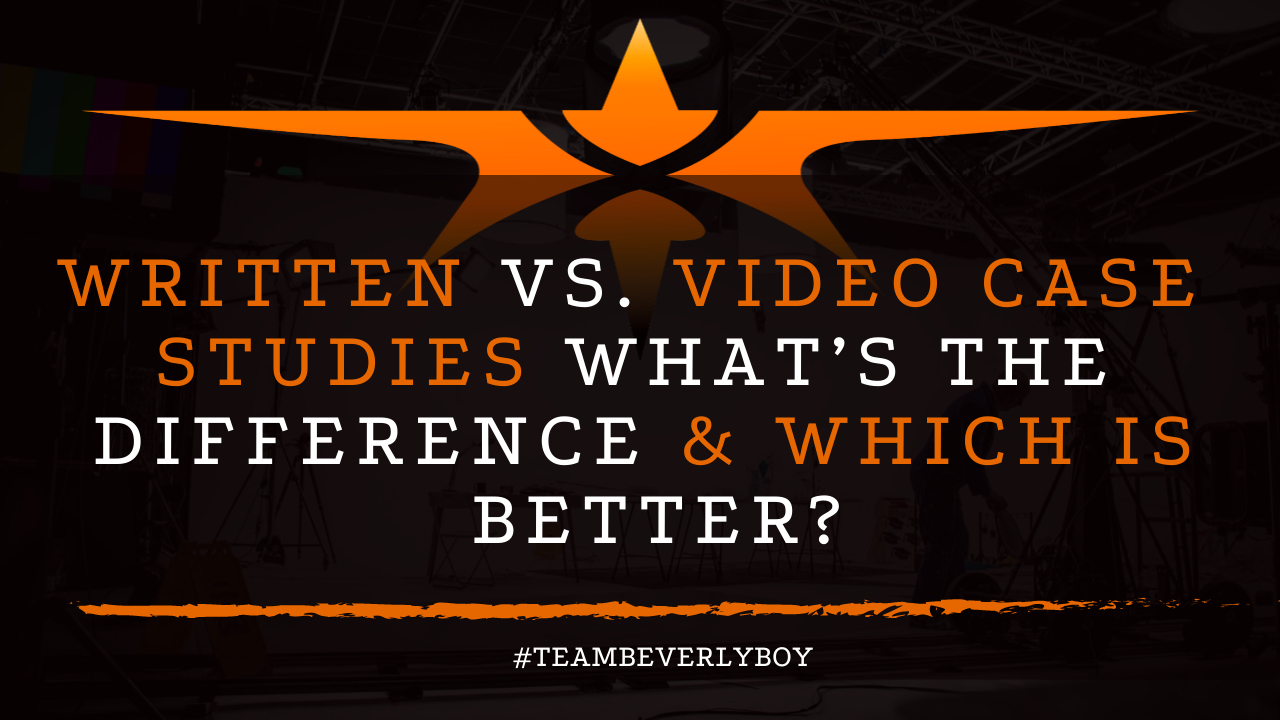
Written Vs. Video Case Studies What’s the Difference & Which is Better?
Case studies are powerful marketing media that have been used for decades to attract the attention of an audience and convince them to trust in the businesses and brands that produce the studies. Long before video was the most popular form of content across the internet, and even before we had internet at all, there were written case studies. Today, case studies are found in both written and video formats, so when talking about written vs. video case studies, which is better?

video case study quote here!
At Beverly Boy Productions, we certainly believe that video case studies outshine written case studies for several key reasons, but because we may be partial to our beliefs because we are a professional film production company and all, we thought it would be fun to compare the two side by side.
Written vs. Video Case Studies Differences
A written case study can be used in a variety of ways across your website, or in print, to share with your target audience, but is it better than a video? There are certainly differences between written and video case studies, some that are surely more valuable to viewers or readers than others.
For example, a written case study is less immersive and requires the audience to actually read through the study in order to fully grasp the magnitude of the data that is included within. Consider the fact that more than 36M American adults cannot read enough to work, and many more struggle to read at a proficient level, when you create a written case study you run the risk of not being able to get your work in front of the millions of people that cannot read it.
Video case studies have more immersion and do not require reading, which means that you can get you work in front of a massive audience, including at least, potentially, 36M more adults that may not be able to read but which can watch video as well as the many others that may not read proficiently.
Additionally, when people do read, they tend to retain less than 20% of what they read and that is if they read word for word, every single page of your case study. Video case studies are going to be retained more fully because when people watch a video they retain upwards of 90% of what they see. So just by shifting from a written to video case study you can gain significant audience attention and retention, too.
Written vs. Video Case Studies: Is One Better than the Other?
Case studies are all about trust and authenticity which is the purpose of producing a case study for your business or brand. So when we talk about written vs. video case studies, it’s hard to state that a written case study would be better, because we want to build content that delivers on the intended promise. A case study, produced to increase trust and showcase brand authenticity, struggles to do that if the content is in written format. People cannot see the interview subjects that answered the questions that made up the case study when it’s written and they may struggle to grasp all of the data that is provided, even if you do include visuals in the written document. The authenticity is lost in the written work.
A video case study on the other hand, has the power of showcasing to your prospects what your subject looked like, and sharing word for word what they said during the interview process. This not only makes the case study video feel more authentic for your audience, but it allows your audience to see past customers that you’ve worked with which they may relate with.
A great case study video is going to have the following benefits over a written case study:
- Videos have the power of social proof, showing off the past customer that trusted your brand to the prospects. Social proof effects are further increased with the visual reinforcement of the video.
- Videos tap into the emotions of the audience. With video you are able to showcase the emotional authenticity of your subject, as he or she shares the story of working with your business or brand.
- Videos instantly attract the audience, and including a hook at the beginning has the power to draw the audience even further into the sight of the moving images. It takes just 1/10th of a second.
- Video case studies create visual connections that are more likely to be trusted among the target audience.
- People find video easier to engage with than written work. Largely in part because people find video easier to watch than it is to read a long case study, but also because with video you get full immersion of moving images, aural sounds, and even sometimes interactive clickable elements, too.
- Up to 75% of people will watch a video whereas only a small fraction will read a case study and many who do read will skim only grabbing small portions of the content.
So, when we talk about written vs. video case studies, there are several major differences that draw our attention to a video being the better choice. What do you think?


